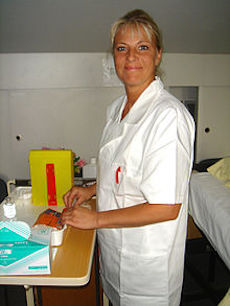Hospital & Health Networks reports that Sharp HealthCare’s Chula Vista (Calif.) Medical Center trial of a real-time location system (RTLS) patient-tracking program is improving the hospital’s patient management.
The hospital’s director of acute care, Deanna White, R.N., told H&HN that that the RTLS, originally used by Chula Vista for asset tracking, has been expanded to apply to patients. Ms. White has been leading the system’s implementation.
“Each patient is assigned a numbered tag with a barcode, which is scanned and connected to software. Infrared technology and beacons in the hospital pick up the tracker’s signal (pictured right) and immediately update the software.” the news service reported.
“The main benefit of the system is in expediting patient throughput and bed turnover. As soon as a patient is discharged, the tag is removed and placed in a special drop box, which pages housekeeping to clean the room. Previously, housekeeping was notified manually. The automated system has decreased the time it takes to get a patient to a room from admit order to occupy by 191 minutes.”
To read more, please hit this link.






